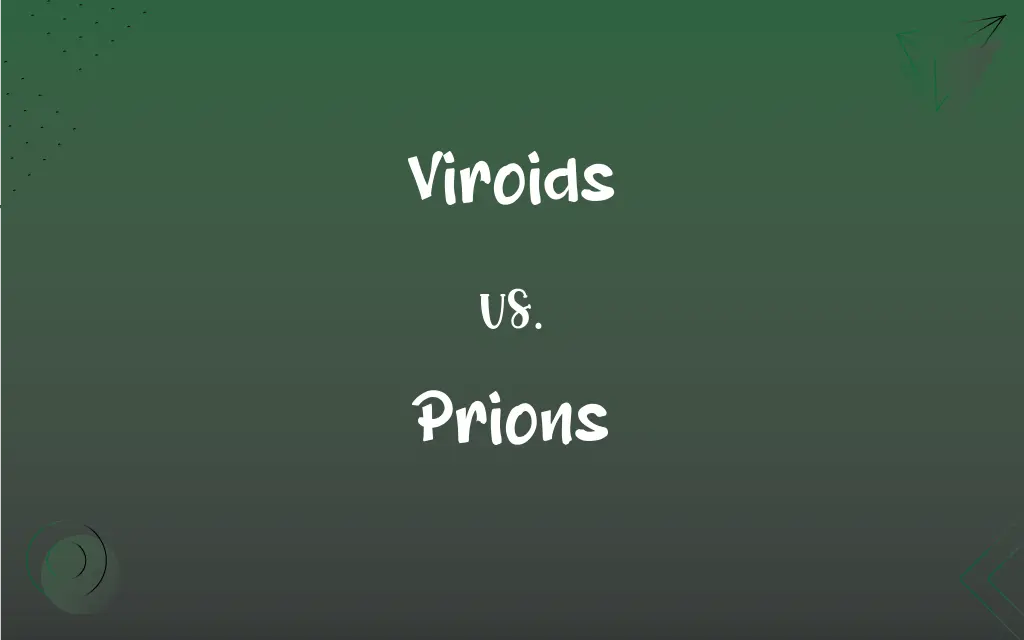Viroids vs. Prions: What's the Difference?
Edited by Janet White || By Harlon Moss || Updated on October 26, 2023
Viroids refers to infectious RNA molecules. Prions refers to infectious proteins.

Key Differences
Viroids are simple plant pathogens, composed entirely of a short strand of circular RNA, without any protein coating. Prions, in contrast, are infectious agents consisting of misfolded proteins, affecting the nervous systems of animals, including humans.
Viroids are known for causing various plant diseases, and their RNA does not encode any proteins. Prions cause diseases like mad cow disease, and are proteins that can induce abnormal folding of normal cellular proteins.
The replication mechanism of viroids occurs within the host cell, exploiting the cellular machinery. Prions replicate by converting normal proteins into the prion form, through a change in shape rather than reproduction.
Viroids are among the smallest infectious pathogens, solely relying on host cell enzymes for replication. Prions are larger, consisting of proteins, and can exist in both normal and infectious forms in organisms.
While both viroids and prions cause disease, viroids are limited to plants, and prions primarily affect animal species, including humans, leading to neurodegenerative disorders.
ADVERTISEMENT
Comparison Chart
Nature
Circular RNA molecules.
Misfolded proteins.
Infectivity
Infect plants.
Infect animals, including humans.
Replication
Utilize host's cellular RNA.
Convert normal proteins to prions.
Diseases Caused
Plant diseases.
Neurodegenerative diseases.
Size
Smaller.
Larger.
ADVERTISEMENT
Composition
RNA only.
Protein only.
Viroids and Prions Definitions
Viroids
Circular RNA pathogens without protein coating.
Citrus trees are often affected by viroids.
Prions
Proteins causing transmissible spongiform encephalopathies.
Kuru, once prevalent in Papua New Guinea, is a prion disease.
Viroids
Smallest known infectious agents.
Viroids replicate inside plant cells.
Prions
Misfolded proteins causing neurodegenerative diseases.
Creutzfeldt-Jakob disease is caused by prions.
Viroids
Infectious RNA molecules causing plant diseases.
The potato spindle tuber disease is caused by a viroid.
Prions
Infectious proteins transmitting fatal brain diseases.
Prions are responsible for mad cow disease.
Viroids
Autonomous replicating RNA causing plant disorders.
The avocado sunblotch is a result of a viroid infection.
Prions
Abnormal isoforms of cellular proteins, infectious.
Prions are unique in their ability to propagate without nucleic acids.
Viroids
Non-coding RNA molecules, pathogenic to plants.
Viroids can severely impact agricultural crops.
Prions
Pathogenic agents inducing abnormal protein folding.
Prions can turn normal brain proteins into diseased forms.
Viroids
An infectious particle, similar to but smaller than a virus, that consists solely of a strand of RNA and is capable of causing disease in plants.
Prions
Plural of prion
Viroids
Plural of viroid
FAQs
What are prions?
Prions are misfolded proteins that cause neurodegenerative diseases.
How do viroids replicate?
Viroids replicate by hijacking the host plant's cellular machinery.
What are viroids?
Viroids are infectious RNA molecules that cause diseases in plants.
How do prions replicate?
Prions replicate by inducing the misfolding of normal proteins.
Are viroids visible under a microscope?
Due to their small size, viroids are not typically visible under a light microscope.
Can prions affect any animal?
Prions primarily affect mammals, but not all animal species are susceptible.
Can viroids infect humans?
No, viroids are known to infect only plants.
What types of diseases do viroids cause?
Viroids cause various plant diseases, often affecting crops.
Can viroids be treated?
There's no direct treatment for viroids; control often involves removing infected plants.
How are viroids transmitted?
Viroids can be transmitted through infected plant material and mechanical tools.
Do prions contain RNA or DNA?
No, prions are purely proteinaceous and do not contain nucleic acids.
Are prions infectious to plants?
Prions primarily infect animals, including humans, not plants.
Do viroids contain any proteins?
No, viroids are made up solely of RNA without any protein coating.
Is there a cure for prion diseases?
Currently, there is no cure for prion diseases.
How are prions transmitted?
Prions are transmitted through ingestion of infected tissue or hereditary factors.
Can prions be destroyed by cooking?
Prions are remarkably resistant and are not reliably destroyed by normal cooking temperatures.
Are viroids considered living organisms?
Viroids are not considered living organisms; they are infectious RNA molecules.
What's the impact of viroids on agriculture?
Viroids can have significant economic impacts by damaging crops.
What diseases are caused by prions?
Prions cause diseases like mad cow disease and Creutzfeldt-Jakob disease.
Are there vaccines for prion diseases?
Currently, there are no vaccines available for prion diseases.
About Author
Written by
Harlon MossHarlon is a seasoned quality moderator and accomplished content writer for Difference Wiki. An alumnus of the prestigious University of California, he earned his degree in Computer Science. Leveraging his academic background, Harlon brings a meticulous and informed perspective to his work, ensuring content accuracy and excellence.
Edited by
Janet WhiteJanet White has been an esteemed writer and blogger for Difference Wiki. Holding a Master's degree in Science and Medical Journalism from the prestigious Boston University, she has consistently demonstrated her expertise and passion for her field. When she's not immersed in her work, Janet relishes her time exercising, delving into a good book, and cherishing moments with friends and family.































































